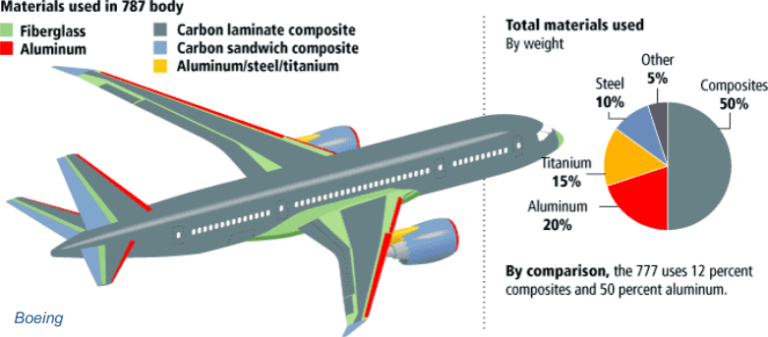1. Introduction
The desire for quick and inexpensive travel around the world and into the space has been the major driving force along the past century for the improvements and innovations of aerospace materials. Coming from wooden frames to fiber reinforced composite polymers and dreaming about self-cleaning and self-healing materials, we can observe that the development process of the aerospace materials has primarily focused on weight reduction, improving damage tolerance, fatigue and corrosion resistance.
In the paper ‘Recent Advances in the Development of Aerospace Materials’, Xuesong Zhang et al. present a very detailed overview of the material requirements in the design of aircraft structures and engines, recent advancements in aerospace materials, challenges and future trends.
2. The design criteria for aerospace materials
Different components of the aircraft require different material properties, so the design requirements vary among the components in consideration owing to the different loading conditions, manufacturability, geometric limits, environmental aspects and maintainability.
2.1. The design criteria for airframe materials
The airframe materials provide shape, structural rigidity, and long term support to static (time independent constant loads, eg. self weight) and dynamic loads (time varying loads especially during service) occurring in the aircraft. They, further, have to withstand the highly varying environmental conditions. So, it is desired that they be of minimum weight and have the appropriate mechanical and thermal properties.
Consider the aircraft wing. It is greatly subjected to bending. The wings’ upper surface is under compression during flight due to net upward lift force, and at tension during taxiing (movement of aircraft on the ground) due to downward acting weight. The bottom surface in under the opposite loading. Therefore, the wing materials should provide both high tensile strength and high compressive strength.
Likewise, the fuselage should withstand high cabin pressurization and shear forces, and requires materials with high tensile and shear strength.
Aluminum based alloys are most widely used as airframe materials. However, the use of polymer matrix composites is rapidly increasing because of their high strength and elastic modulus, and greater high-temperature resistance.
2.2. The design criteria for aircraft engine materials
Thrust improvement and engine weight reduction are two major scopes of designing aircraft engines. So, the engine materials should have low density, good high temperature mechanical properties, and excellent corrosion resistance.
The engine generally consists of two sections: cold and hot.
Cold section, consisting of fan, compressor and casing, requires material with high specific strength (strength per unit mass), and corrosion resistance. Titanium based alloys (eg. Ti-6Al-2Sn-4Zr-6Mo) are generally used in this section because of their high strength (Yield Strength = 640 MPa) at high temperature (450 °C) and excellent corrosion resistance.
Hot section, consisting of combustion chamber and turbine, requires materials with high specific strength, creep resistance (resistance to deformation over the long period of exposure to high level of stress), hot corrosion resistance, and high temperature resistance. Since the operating temperatures (1400 °C – 1500 °C) greatly exceed the limit of Ti based alloys, Nickel based super alloys (eg. Ni-14.5Zr-3.2Mo) are used in this section.
3. Recent advances in aircraft materials
3.1 Al-based alloys
Recent researches primarily focus on 2000, 7000 series Al-based alloys and Al-Li alloys. Even though the composites seem to greatly replace Al-based, they still offer significant advantages such as low cost, easy manufacturability, light weight, and high stress resistance.
3.1.1. 2000 series Al-Cu alloys
2000 series Al-based alloys are generally alloyed with copper. Since they posses superior damage tolerance, and better fatigue resistance than any other series of Al-based alloys, they are widely studied as aircraft fuselage materials. However, because of their relative low strength, they cannot be used in high stress region.
Their proper combination with Sn, In, Cd, or Ag can provide better mechanical properties due to refinement in microstructure and grain size. Further, the mechanical properties can also be improved by reducing the content of impurities like iron and silicon.
3.1.2. 7000 series Al-Zn alloys
7000 series Al-based alloys are generally alloyed with zinc. Zinc has the highest solubility in Aluminum (31.6% wt) than any other element. Since Al-Zn based alloys have highest strength as compared to any other Al-based alloys, they are used in upper wing skin, stringers and stabilizers where strength is major consideration. However, these alloys have low fracture toughness and damage tolerance,and poor corrosion resistance.
Their proper combination with Zr or Mn can provide better mechanical properties. For eg. Mn content at 1% wt can improve the fracture toughness of 7000 series alloys by almost 100 percent (from 25 MPam0.5 to 52MPam0.5 for 7075 alloy). Reducing impurities like iron and silicon also offers better mechanical properties.
3.1.3. Al-Li based alloys
Al- Li based alloys are the lightest Al-based alloys and posses low density and high specific mechanical properties as compared to 2000 and 7000 series alloys. The use of Al- Li based alloys on fuselage skin and upper wing skin in place of 2000 and 7000 series alloys respectively can save the weight by around 10%.
However Li-Al alloys are prone to anisotropy problem, i.e. variation of properties in different directions. Further, they also possess low toughness and poor corrosion resistance. Recent studies are focused on solving these shortcomings.
3.2. Mg-based alloys
Magnesium is considered as the lightest structural metal. Even though it can decrease the weight of the structure by 33% as compared to the same volume of aluminum and by 77% as compared to the same volume of steel, its use in aerospace industry is very limited because of insufficient mechanical properties, and poor corrosion resistance.
The proper combination of Al, Zn, Zr, or rare earth elements such as Yttrium(Y) with Mg-based alloys can improve mechanical properties. Addition of Al will improve corrosion resistance. Further, addition of zinc up to some critical level (5%wt) in Mg-Al alloy increases strength and ductility. In absence if Al, Mg-Zn can be combined with Zr or Y to significantly improve strength. For eg. Mg97Zn1Y2 alloy has the highest strength (YS=610MPa) among Mg-based alloys.
3.3. Ti-based alloys
The use of titanium based alloys has seen a gradual increase in recent years mainly because of their high specific strength, excellent corrosion resistance and well high temperature performance. They are used as aircraft spring, helicopter rotor systems and engine compressor parts. Ti-based alloys are divided into alpha, beta, and alpha-beta titanium alloys.
3.3.1. Alpha titanium alloys
These are the titanium alloys with hexagonal close packed (HCP) crystal structure. Alpha titanium alloys have a lower density, higher creep resistance and better corrosion resistance than beta titanium alloys. Therefore alpha titanium alloys like Cp-Ti, Ti-3Al-2.5V, etc. are used in compressor blades in aircraft engines. However, their functionality is highly limited at high temperatures. Al is widely used to improve their high temperature performance.
3.3.2. Beta titanium alloys
These are the titanium alloys with body centered cubic (BCC) crystal structure. They have higher tensile and fatigue strength than alpha titanium alloys, and are easier to fabricate. Beta stabilizers like V, Mo, Nb, and Cr can reduce the binding energy of the beta-Ti atomic cluster, resulting in stronger bonds between Ti and alloying atoms, thereby increasing the strength of the alloy. For eg. beta titanium alloy, Ti-3Al-8V-6Cr-4Mo-4Zr, has ultimate tensile strength of 1240 MPa and is used in high-stress regions of aircraft like landing gears and springs.
3.3.3. Alpha-beta titanium alloy
Combining the properties from both alpha and beta titanium alloys, alpha-beta titanium alloys boast the excellent strength, fracture toughness, ductility and corrosion resistance. They are the most widely used Ti-based alloys and comprise 70 % share of the U.S. titanium market. Alpha-beta alloys like Ti-6Al-4V and others are used in fuselage, landing gear, floor support structures, nacelles and compressor discs.
3.4. Composite Materials
Composite materials are produced from two or more dissimilar materials, which are combined to give the properties unlike the individual constituent. The use of composite materials is booming in aerospace industry with them constituting more than 25% of the Airbus A380 and 50% of Boeing 787. Composite materials have low density, and thus higher specific strength and better corrosion and fatigue resistance than most metals.
3.4.1. Ceramic matrix composites (CMC)
CMCs consist of ceramic fibers embedded in a ceramic matrix. CMCs like silicon carbide(SiC), alumina(Al2O3), silicon nitride(Si3N4) etc. have excellent high-temperature stability(even at 1400 °C), high hardness, and high corrosion resistance. Therefore, they are usually used in high temperature regions like exhaust nozzle.
However, ceramic matrix composites have poor fracture toughness. Recent studies have focused on the use of carbon nanotubes(CNT) and graphene nanaoplatelets(GNP) to improve CMCs fracture toughness. Scientific experments have shown that fracture toughness of Si3N4 can increase by 235% by adding 1.5 vol% of graphene.
3.4.2. Metal matrix composites (MMC)
MMCs consist of reinforcing materials dispersed in a metal matrix. MMCs have higher yield strength, fracture toughness, low thermal expansion, and suitable wear resistance.
Metals like Al, Mg, Ti, Cu and Ni are used as matrix. Carbon fibers and glass fibers are commonly used reinforcing materials. However, these fibers have already offered the maximum limit of their ability. So, new materials like carbon nanotubes (CNTs) and graphene nanosheets are being studied for improved mechanical properties. It has been found that the mechanical properties ( like tensile strength, yield strength, hardness) of Mg, Ti, Al, Cu, and Ni matrix composites will improve with the controlled addition of CNTs.
3.4.3. Polymer matrix composites (PMC)
PMCs are composed of short or continuous fibers bound together by an organic polymer matrix. Fiberglass, graphite and aramid are commonly used fibers. Depending upon the characteristics of polymer matrix, PMCs are classified as thermoset (cannot be heat remolded) and thermoplastic(can be heat remolded). Thermoset matrices like epoxy, polyurethanes, polyamides, etc. are widely used to develop PMCs for aerospace industry which are used in ailerons, flaps, and landing gear doors.
PMCs are known for their higher specific strengths and specific modulus. For eg. as compared to the Al-based alloys, the density of carbon fiber reinforced in an epoxy matrix binder is half, and the tensile strength and elastic modulus are three times and two times higher, respectively.
However, the carbon fibers are prone to stress concentration due to their brittleness. So natural fibers (like flax, hemp, banana, bambo, etc.), carbon nanotubes, graphene, and basalt are currently being investigated as reinforcing materials for polymer matrix.
3.5. Steels
The use of steels in the aerospace industry has rapidly decreased in recent years because of its low specific strength and corrosion resistance. Even though it(mild steel) has quite high ultimate tensile stress (840 MPa), its greater density means that its specific properties are unsuitable for flying. However, it is still a major material for gears, bearings, carriages and fasteners.
New low alloy steels and nanosteels are currently being studied for better specific properties and corrosion resistance.
3.6. Ni-based superalloys
Ni-based superalloys have very high strength even at high operating temperatures. Therefore, they are widely used in combustion chamber and turbine section of the aircraft engine where the operating temperatures range between 1100 and 1250 °C. Inconel (composed of Ni >72%, Cr 14%-17%, Fe 6%-10%, and little Mn, Cu, Si, S, C) and Nimonic (composed of Ni 54%, Cr 18–21% ,and some Co, Ti, Al) are the most popular Ni-based superalloys. Al is added to nickel-based superalloys to improve their oxidation resistance.
4. New potential materials for future aircraft
With the technological advancement marching forward, self- cleaning polymerics and self-healing materials have a huge potential as the aerospace materials of the future.
Self-cleaning materials can be found in the natural environment, with lotus leaves being an example. If water is poured over these leaves, it rolls of as beads and cleans the dirt on the leaves. There are two known mechanisms for self cleaning surfaces.
a. Based on wettability of surface as in lotus leaves
b. Based on photocatalytic feature, where light is captured by the photoactive surface, which then produces oxidative radicals that can mineralize and absorb organic molecules.
Future self-cleaning materials can be developed based on these properties, and can be applied to fabric of seats and carpets, and who knows, maybe even to the skin of the future aircraft.
Self-healing or self repairing materials are another scope of study which will significantly contribute to keep the functioning intact even after corrosion or mechanical damage. They can de divided into two categories:
a. Intrinsic self-healing materials: These materials can restore back to their structural integrity without any outside help. In these materials, local increase in mobility of the polymeric chains allows crack to be repaired on their own. For eg. wolverine fabric.
b. Extrinsic self-healing materials: These materials use healing agent stored in the material in advance, which is released when triggered by cracks.
Self healing materials containing Boron can be used in aircraft engines, which through the formation of B2O3 can seal the matrix cracks at high temperature. Likewise, self-healing epoxy composites which can produce coatings can be used to protect aircraft structures from corrosion.
5. Challenges in development of advanced materials
5.1. Fretting Wear
It is the wear at the contact surface due to small amplitude (less than about 100 µm) oscillatory relative movement between the surfaces. It creates the crack initiation which slowly develops into fringes, and eventually causes rupture. No material is free from fretting wear, and the challenge lies in developing techniques to minimize it. To further complicate the problem, the general theory that identifies the fretting behavior and the prevention of fretting is still unclear. However, experiments have shown that the modification of surface hardness and adhesion can greatly influence fretting wear.
5.2. Corrosion
Reaction with the surrounding causes chemical change or degradation in the material, known as corrosion. Corrosion can be uniform corrosion, pitting corrosion, crevice corrosion, or galvanic corrosion. It is one of the major cause of structural collapse. In the United States alone, metal corrosion causes a loss of $276 billion per year, which is much greater than the loss caused by the natural disasters. Based on statistical predictions, only 30% of the corrosion loss can be prevented by the prevention methods. Further, in aerospace, not all the high corrosion resistant materials can be used. Therefore, it is a great challenge to protect aircrafts from corrosion by developing new materials or by innovating much effective techniques.
6. Conclusion
The aerospace industry has definitely taken a giant leap within the past century, and much of the progress is due to development and innovation of structural and engine materials. High performance aircraft alloys like AL-based alloys, Mg-based alloys, Ti-based alloys, and Ni-based alloys, together with composite materials, are the backbone of current aerospace industry. However, they still face several challenges like corrosion, and fretting wear. Thus, it is imperative that extensive research activities should be continued to develop next generation aerospace materials with superior mechanical properties, and corrosion resistance if we are to make air travel more secure, efficient, and economical.
Original Paper:
Was this summary helpful?
Mention in the comments section below.
Do not forget to check our other research paper summaries, and general blog posts.








